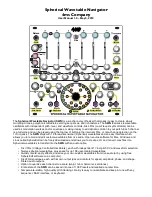
F-em User Guide
•
Spread
: Adjusts the relative time of the first repetition
compared to the delay length. A value of 0 % means that the
delay of both stereo sides produce their first repetition at the
same time while smaller values result in the left side repeating
first and larger values result in the right side repeating first.
This allows you to create ping-pong delays. E.g., when setting
Clock
to 1/4 and
Spread
to –50 % you get an 1/8 ping pong
delay. Other interesting
Spread
percentages are 33 % for
triplets or ±50 % for dotted notes, provided that
Clock
is set to
a straight value. If
Clock
is set to a dotted value, you would, for
example, set
Spread
to 333 % to have one of the repetitions
straight. Also interesting are only slight deviations from 0 %,
creating deeper delays. Sounds complicated, but offers a lot of
fun.
•
Mod Speed
: Controls the modulation speed.
•
Low Cut
: Removes low frequencies before the signal enters the
delay stage so that the first repetition is already filtered.
•
High Cut
: Removes high frequencies before the signal enters
the delay stage so that the first repetition is already filtered.
•
Mod Depth
: Adjusts the strength of the modulation, resulting
in a detune effect.
•
Low Damp
: Removes low frequencies in the feedback stage.
•
High Damp
: Removes high frequencies in the feedback stage
of the delay meaning that each repetition has less and less high
frequencies.
•
Pan
: Determines the stereo panning of the delay effect.
Reverb Natural / Reverb Plate / Reverb Non-Linear
F-em features high-quality reverb
algorithms in different flavors. They all
share common parameters.
The reverb natural algorithm simulates the
reverberation that occurs in natural rooms.
The names suggest the basic size of the
simulated room although you can create
artificially sounding rooms by changing the
reverb time to unnatural values.
The Reverb Plate algorithm simulates a
reverb plate. In the late 1950‘s, the German
company EMT (Elektro-Mess-Technik)
introduced huge steel plates fitted with a
loudspeaker and a microphone. A signal
would be sent to the loudspeaker and
recorded by the microphone including the
vibrations the steel plate generated
resulting in a smooth but slightly artificial
sounding reverb. The Plate Reverb and its
digital simulation is suited well for drum and
percussion sounds due to their dense initial
reflections.
The non-linear reverb algorithm generates
typical gated reverb effects (although it
works completely differently) or inverse
reverbs. Since it doesn‘t have an internal
feedback it must produce the whole reverb in one turn to create the
gate effect. This means that longer reverb times sound less dense than
42
















































